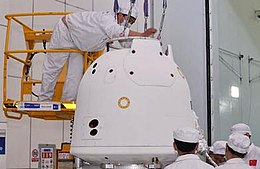 Chang'e 5-T1's re-entry module after vacuum thermal tests | |
| Mission type | Chang'e 5 precursor mission, lunar flyby and Earth reentry |
|---|---|
| Operator | CNSA |
| COSPAR ID | 2014-065A |
| SATCAT no. | 40283 |
| Mission duration | 8 days, 4 hours, 42 minutes Return capsule 6 years, 1 month, 1 day Flyby/orbiter bus |
| Spacecraft properties | |
| Bus | DFH-3A [1] |
| Manufacturer | CAST |
| Launch mass | 3,300 kg [2]; (Service Module approximately 2,215 kg, return capsule under 335 kg) |
| Start of mission | |
| Launch date | 23 October 2014, 18:00 UTC [3][4] |
| Rocket | Long March 3C/G2 |
| Launch site | Xichang LC-2 |
| End of mission | |
| Last contact | 24 November 2020, 08:50 UTC[5] Flyby/orbiter bus |
| Landing date | 31 October 2014, 22:42 UTC[6][7] Return capsule |
| Landing site | Siziwang Banner, Inner Mongolia |
| Orbital parameters | |
| Reference system | Geocentric |
| Regime | Lunar free return |
Chang'e 5-T1 (Chinese: 嫦娥五号T1; pinyin: Cháng'é wǔhào T1) was an experimental robotic spacecraft that was launched to the Moon on 23 October 2014, by the China National Space Administration (CNSA) to conduct atmospheric re-entry tests on the capsule design planned to be used in the Chang'e 5 mission.[3][8][9] As part of the Chinese Lunar Exploration Program, Chang'e 5, launched in 2020, was a Moon sample return mission. Like its predecessors, the spacecraft is named after the Chinese Moon goddess Chang'e. The craft consisted of a return vehicle capsule and a service module orbiter.[10]
The return capsule of Chang'e 5-T1, named Xiaofei (Chinese: 小飞), meaning "little flyer" in Chinese, landed in Siziwang Banner, Inner Mongolia, on 31 October 2014, 22:42 UTC. The CE-5-T1 Service Module entered lunar orbit on 13 January 2015.[11] Its initial orbit was 200 x 5,300 km with a period of 8 hours.
- ^ Cite error: The named reference
Gunterwas invoked but never defined (see the help page). - ^ "Chang'e 5-T1" (PDF). NASA. Retrieved 30 November 2022.
- ^ a b "Chinese Long March Rocket successfully launches Lunar Return Demonstrator". Spaceflight101. 23 October 2014. Archived from the original on 24 September 2015. Retrieved 23 October 2014.
- ^ "China launches test return orbiter for lunar mission". Xinhuanet. 24 October 2014. Archived from the original on 23 October 2014.
- ^ Cite error: The named reference
c5t1_2020was invoked but never defined (see the help page). - ^ "China completes first mission to moon and back". Space Daily. 1 November 2014. Retrieved 1 November 2014.
- ^ "中国探月工程三期再入返回飞行试验获圆满成功". 中国新闻网. 31 October 2014.
- ^ "CLunar mission:craft to conduct re-entry tests before 2015". Xinhuanet. 14 December 2013. Archived from the original on 31 October 2015.
- ^ "China's Lunar Probe Tester Ready for Chang'e 5 Mission". CRIEnglish News. 11 August 2013. Archived from the original on 19 October 2014.
- ^ "Chang'e 5 Test Mission". Spaceflight 101. Retrieved 8 December 2018.
- ^ "Service module of China's lunar orbiter enters 127-minute orbit - Xinhua | English.news.cn". Archived from the original on 25 January 2015.